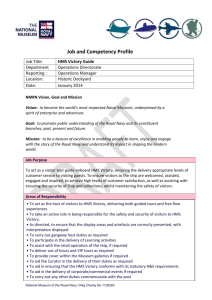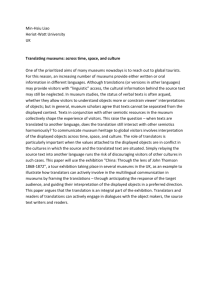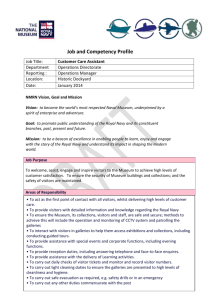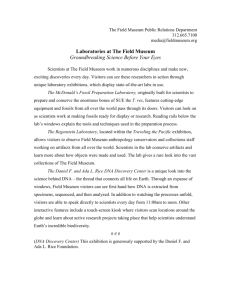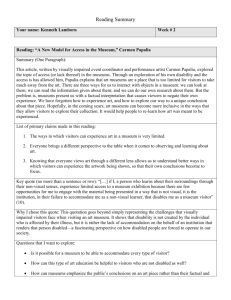Author: Maurice Davies Published Date: Title: Ekarv text method in
advertisement
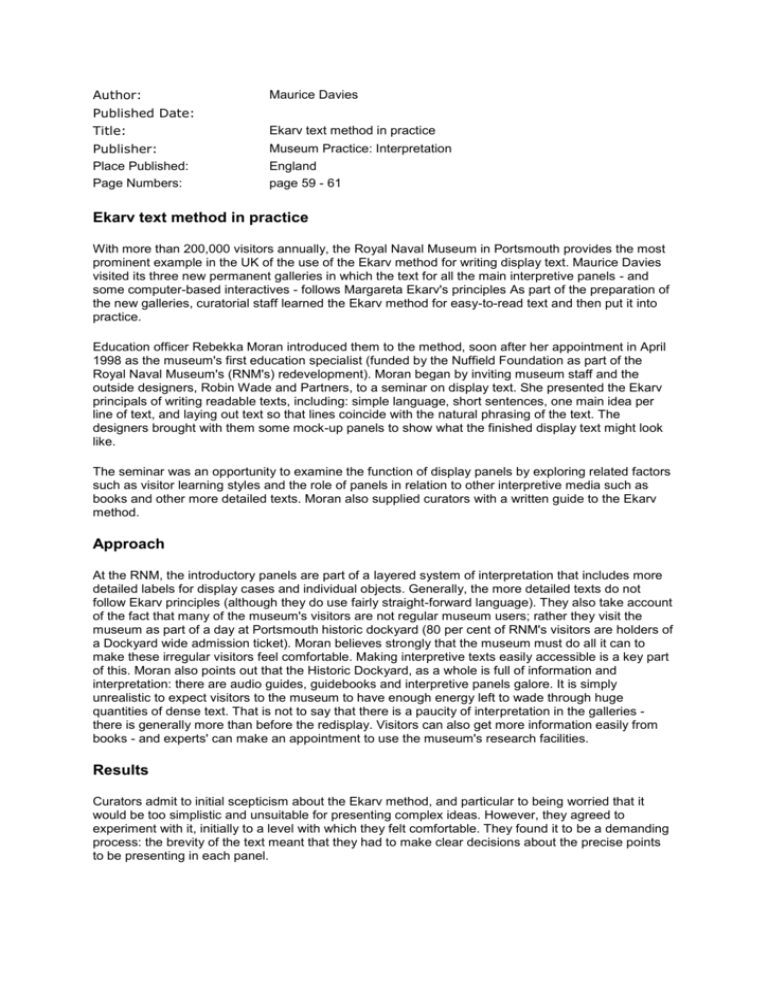
Author: Maurice Davies Published Date: Title: Ekarv text method in practice Publisher: Place Published: Page Numbers: Museum Practice: Interpretation England page 59 - 61 Ekarv text method in practice With more than 200,000 visitors annually, the Royal Naval Museum in Portsmouth provides the most prominent example in the UK of the use of the Ekarv method for writing display text. Maurice Davies visited its three new permanent galleries in which the text for all the main interpretive panels - and some computer-based interactives - follows Margareta Ekarv's principles As part of the preparation of the new galleries, curatorial staff learned the Ekarv method for easy-to-read text and then put it into practice. Education officer Rebekka Moran introduced them to the method, soon after her appointment in April 1998 as the museum's first education specialist (funded by the Nuffield Foundation as part of the Royal Naval Museum's (RNM's) redevelopment). Moran began by inviting museum staff and the outside designers, Robin Wade and Partners, to a seminar on display text. She presented the Ekarv principals of writing readable texts, including: simple language, short sentences, one main idea per line of text, and laying out text so that lines coincide with the natural phrasing of the text. The designers brought with them some mock-up panels to show what the finished display text might look like. The seminar was an opportunity to examine the function of display panels by exploring related factors such as visitor learning styles and the role of panels in relation to other interpretive media such as books and other more detailed texts. Moran also supplied curators with a written guide to the Ekarv method. Approach At the RNM, the introductory panels are part of a layered system of interpretation that includes more detailed labels for display cases and individual objects. Generally, the more detailed texts do not follow Ekarv principles (although they do use fairly straight-forward language). They also take account of the fact that many of the museum's visitors are not regular museum users; rather they visit the museum as part of a day at Portsmouth historic dockyard (80 per cent of RNM's visitors are holders of a Dockyard wide admission ticket). Moran believes strongly that the museum must do all it can to make these irregular visitors feel comfortable. Making interpretive texts easily accessible is a key part of this. Moran also points out that the Historic Dockyard, as a whole is full of information and interpretation: there are audio guides, guidebooks and interpretive panels galore. It is simply unrealistic to expect visitors to the museum to have enough energy left to wade through huge quantities of dense text. That is not to say that there is a paucity of interpretation in the galleries there is generally more than before the redisplay. Visitors can also get more information easily from books - and experts' can make an appointment to use the museum's research facilities. Results Curators admit to initial scepticism about the Ekarv method, and particular to being worried that it would be too simplistic and unsuitable for presenting complex ideas. However, they agreed to experiment with it, initially to a level with which they felt comfortable. They found it to be a demanding process: the brevity of the text meant that they had to make clear decisions about the precise points to be presenting in each panel. Moran says that she "gently guided" curators through the process, responding to requests for advice, but without being prescriptive. Staff sometimes worked in small groups to discuss possibilities. The final decision about the wording of each piece of text remained with the curator who wrote it. Gradually, the curators became convinced of the merits of Ekarv, and more confident about using it as they put it into practice. By the third gallery (the Victory gallery), they were using Ekarv in its most pure and poetic' form. One curator comments: "To move away from Ekarv now would be a big step backwards - visually and educationally." Visitors now seem to spend longer in each of the refurbished galleries (although there have been a great many changes in addition to the use of Ekarv texts) and a limited visitor survey has showed that visitors like the display panels, with 83 per cent rating them as "excellent" or "very interesting". Visitors' comments include: "The accompanying text is extremely clear and readable. Short sentences are a very good idea and Quite the most interesting, informative and well presented exhibition I have ever seen'. in contrast, one visitor noted: Everything was wonderful except the text explanations on the exhibits were not very adult; seemed to be aimed at children; very simplistic. The RNM's director, Campbell McMurray, is convinced of the benefits of the Ekarv method and rejects the view that simpler texts mean that visitors learn less. in fact, the opposite is true. Remembering how little time most people used to spend in the old galleries, he comments: "We perhaps used to be rather over optimistic in our assumptions about what visitors learned." Other benefits of the Ekarv approach are the consistency it has given to texts Written by several different curators, and the concise, straightforward language, which is easier for visitors with a limited knowledge of English to read and translate. It also works well when people read it to others, for example when adults read to children. So far there is only anecdotal evidence that. the Ekarv approach supports visitor learning better than more conventional texts. As the method gains in popularity there may be a case for a more formal evaluation of its effectiveness. Ekarv at the Royal Naval Museum The Royal Naval Museum (RNM) followed the standard guidelines for Ekarv text, as presented in Museum Practice (issue 5,p72-75) and repeated below. However, staff at the museum emphasise that Ekarv should be seen more as an underlying philosophy than a series of steps to follow. They also warn against employing Ekarv without first being clear that it is suitable for an individual museum's circumstances, including its site and its actual and target audiences. They advise others to use the system flexibly, adapting the guidelines set out below - or If necessary using a completely different system - to suit the needs of the museum, and with which they feel comfortable. For example, at the RNM they included specialist terms, but always put them in bold type and made sure that the sentence surrounding them was simple. Guidelines for the Ekarv text method Education officer Rebekah Moran warns that using Ekarv may not be easy and cautions others to: Take care not to over simplify concepts because the language is simple Make sure that texts do not become patronising as a result of their succinctness and simplicity Use simple language to express complex ideas Use normal spoken word order One main idea per line, end of line coinciding with natural end of phrase Lines of about 45 letters, text broken into short paragraphs of four to five lines Use the active form of verbs and state the subject early in the sentence Read text aloud and note natural pauses Adjust wording and punctuation to reflect the rhythm of speech Discuss texts with colleagues and consider their comments Co-ordinate the text writing with the design of displays Pin draft texts in their final positions to assess the effect Continually revise and refine the wording Concentrate the meaning to an almost poetic level Keep expectations high and do not avoid using the text to challenge visitors but Be alert to the risk of becoming over interested in the formal, poetic qualities of the text at the expense of its meaning Always use the text to focus visitors' attention on the objects on display; do not treat the text as an end in itself. Avoid: subordinate clauses, complicated constructions, and unnecessary adverbs, hyphenating words at the end of lines At the RNM, panel text is a minimum of 14pt, mainly in Baskerville, a serif face, although Moran would have preferred a plainer sans serif face. As well as using the Ekarv method for panels, the museum used it to guide written text on multimedia screens. They also used the Ekarv method as a guide for laying out oral history quotations. White they did not wish to edit the quotations in any way, they followed the Ekarv idea of breaking lines where pauses occur in the text, to make it easier to understand. Maurice Davies is Deputy Director of the Museums Association THE NEW ROYAL NAVAL MUSEUM GALLERIES The RNM has opened three new galleries as part of the first phase of a two-part refurbishment. Almost £3m of the £5,3m project was funded through a grant from the Heritage Lottery Fund. Between them, the three galleries cover the period up to about 1860, under the themes: The Sailing Navy (life on a warship in the 18th and 19th centuries); Horatio Nelson: the hero and the man; and, in a separate building that overlooks HMS Victory itself, a gallery that covers the battle of Trafalgar and the story of HMS Victory (Nelson's flagship at Trafalgar). The galleries, designed by Robin Wade and Partners, combine hands-on and interactive multimedia and audio-visuals with displays of objects. The gallery about Trafalgar and HMS Victory, for example, includes the following elements, in addition to objects displayed in cases: Trafalgar! - A multimedia walk through experience, designed by Sarner International, that allows visitors to experience events from the gun deck of Victory during the battle' A large panorama of the battle painted in 1929-30 by the artist W L Wyllie A small display of Wyllie's life and art A hands-on area at the centre of the main Story of Victory displays. Interactives cover, for example, signalling, knots, sailing and wind direction An audio-visual introduction (in English and French) Multimedia interactives on, for example, firing ship's guns and the Trafalgar quiz (the quiz can be used to collect data to guide staff about visitors' level of knowledge) Works on paper in pull-out racks Panels illustrating individuals who sailed on HMS Victory An oral history display on the restoration of HMS Victory, including recorded testimonies by the people who worked on the restoration, and explanations by experts in various disciplines of why they think it is important to conserve the ship. Throughout the galleries, museum staff has tried to make the displays and interpretation appeal to a wide range of non-specialist visitors. As an example, panels refer to `people' or `crew' rather than `men' and make a deliberate point of referring to the fact that there were women on board some ships. Interpretation is designed to prompt visitors to think and reach their own conclusions. The overriding aim is to stimulate a general interest in history (which visitors might be encouraged to take further), rather than present very specific messages or an authoritative authorial voice. Text Examples Example 1: Panel near a window overlooking HMS Victory itself that aims to encourage visitors to look a little more closely at the ship (the panel includes an annotated diagram to explain the technical terms used in the text) EXAMPLE 2: Interpretive panel EXAMPLE 3: An almost "poetic" example, introducing the idea of oral history

